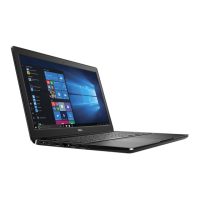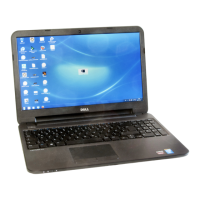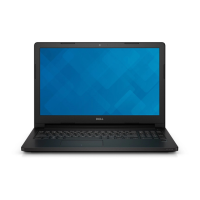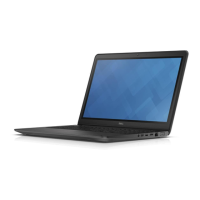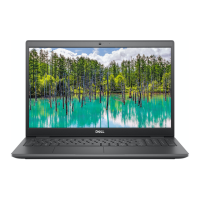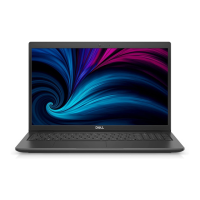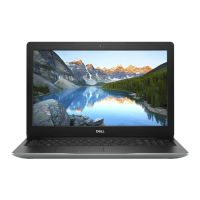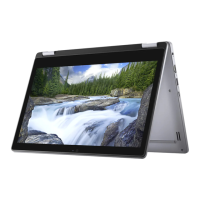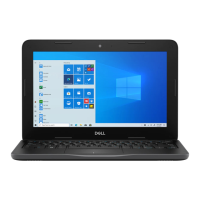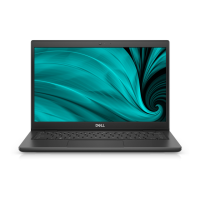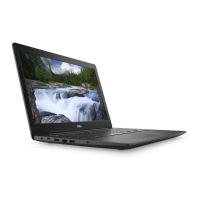
Do you have a question about the Dell Latitude 3590 and is the answer not in the manual?
| Processor | Intel Core i5-8250U |
|---|---|
| Display | 15.6-inch HD (1366x768) or FHD (1920x1080) |
| Memory | Up to 32GB DDR4 |
| Graphics | Intel UHD Graphics 620 |
| Operating System | Windows 10 Pro |
| Weight | Starting at 2.03 kg (4.48 lbs) |
| Battery | 42 Whr |
| Ports | USB 3.1, USB 2.0, HDMI, SD card reader, headphone/mic combo |
| Wireless | 802.11ac + Bluetooth 4.1 |
| Dimensions | 22.7 mm |
Details primary steps before disassembly or break/fix procedures.
Explains how standby power functions and how to discharge residual power.
Describes the method for connecting grounding conductors to the same electrical potential.
Explains ESD as a major concern for handling electronic components.
Details the unmonitored Field Service kit components: mat, wrist strap, and bonding wire.
Critical procedures for safe transport of ESD sensitive components.
Guidelines for lifting heavy weight equipment safely.
Steps to ensure proper preparation before working inside the computer.
Steps to follow after completing any replacement procedure.
Lists the essential tools required for component removal and installation procedures.
Provides a list detailing component screw sizes for correct identification.
Instructions for removing and installing the SIM tray.
Steps for removing and installing the optional SD card.
Instructions for removing and installing the base cover.
Detailed steps for removing and installing the battery.
Procedures for removing and installing the Wireless LAN card.
Instructions for removing and installing the optional Wireless WAN card.
Procedures for removing and installing the VGA board.
Steps for removing and installing the system memory modules.
Detailed instructions for removing and installing the hard disk drive.
Procedures for removing and installing the SSD card.
Steps for removing and installing the system speakers.
Instructions for removing and installing the coin cell battery.
Procedures for removing and installing the heat sink.
Steps for removing and installing the system cooling fan.
Procedures for removing and installing the Input-Output board.
Steps for removing and installing the fingerprint reader.
Procedures for removing and installing the touchpad panel.
Detailed steps for removing and installing the display assembly.
Procedures for removing and installing the DC-in power port.
Steps for removing and installing the power button board.
Procedures for removing and installing the LCD bezel.
Steps for removing and installing the internal camera.
Detailed steps for removing and installing the LCD panel.
Procedures for removing and installing the LCD hinges.
Steps for removing and installing the eDP and camera cables.
Procedures for removing and installing the system board.
Steps for removing and installing the palm rest.
Lists the supported Intel Celeron and Core processors.
Details memory support, SODIMM slots, and configurations.
Lists available storage options like HDD and SSD types.
Details audio features, controller, and interfaces.
Lists video features, controller types, and display support.
Details webcam features, resolution, and imaging rate.
Specifies the Ethernet controller and external connector type.
Details Wi-Fi and Bluetooth card specifications and standards.
Lists available ports like USB, Modem, Audio, and Expansion.
Details display types, brightness, resolution, and refresh rates.
Explains the function of various Fn key combinations.
Lists touchpad dimensions and supported gestures.
Details battery types, capacity, voltage, and dimensions.
Lists specifications for AC adapters, including wattage and voltage.
Lists the physical dimensions and weight of the system.
Details temperature and humidity ranges for operation and storage.
Explains DDR4 memory technology and its benefits.
Highlights subtle differences between DDR3 and DDR4 memory modules.
Describes common memory error codes and troubleshooting steps.
Overview of USB evolution and its features.
Details the features and advantages of USB 3.0/3.1 Gen 1.
Discusses applications and benefits of USB 3.0/3.1 Gen 1.
Explains compatibility considerations for USB 3.0/3.1 Gen 1.
Explains HDMI 1.4 interface and its features.
Introduces the USB Type-C connector and its capabilities.
Explains how USB Type-C supports various protocols via alternate modes.
Details the USB Power Delivery specification for charging.
Clarifies the distinction between USB Type-C connector and USB 3.1 standard.
Allows bypassing system setup for direct booting to devices.
Explains the keyboard keys used for navigating System Setup.
Overview of what System Setup allows users to do.
Step-by-step guide on how to enter System Setup.
Lists primary hardware features of the computer.
Options for configuring system components like NIC, SATA, and Drives.
Configures integrated USB controller and boot support.
Settings for Dell Type-C dock connectivity.
Enables charging external devices via USB PowerShare port.
Options to control keyboard backlight brightness.
Sets timeout for keyboard backlight when on battery.
Controls touchscreen enablement and unobtrusive mode.
Options to enable/disable devices like Camera and SD card.
Options to adjust LCD brightness.
Options for setting Admin, System, and HDD passwords.
Enforces strong password requirements for security.
Specifies minimum and maximum password lengths.
Options to enable/disable Trusted Platform Module (TPM) security features.
Options to enable/disable Secure Boot feature and manage keys.
Specifies secure environment for code and sensitive information.
Options to control multi-core support and processor features.
Settings for AC behavior, auto-on time, and USB wake support.
Options to maximize battery health through charging algorithms.
Settings for adapter warnings, Numlock, Fn keys, and fast boot.
Options to enable Intel Virtualization Technology and VT for Direct I/O.
Settings to control wireless devices via Wireless Switch.
Options for Service Tag and Asset Tag management.
Allows viewing and clearing BIOS, Thermal, and Power events.
Controls automatic boot flow for SupportAssist System Resolution.
Step-by-step guide to update BIOS from within Windows.
Guide to update BIOS when Windows cannot load.
Explains system and setup passwords for computer security.
How to assign system and setup passwords.
Procedures to delete or change existing system and setup passwords.
Lists the operating systems supported by the notebook.
Instructions on how to download and install drivers from Dell.
Explains the importance and installation of the chipset driver.
Verifies installation of drivers for Touchpad, IR camera, and keyboard.
Verifies the installation of the graphics controller driver.
Verifies the installation of USB drivers.
Verifies if audio drivers are already installed.
Recommends installing Intel Rapid Storage driver for best performance.
Lists security devices in Device Manager.
Resets BIOS defaults and system date/time for No POST/No Boot issues.
Invokes ePSA diagnostics to check hardware status.
